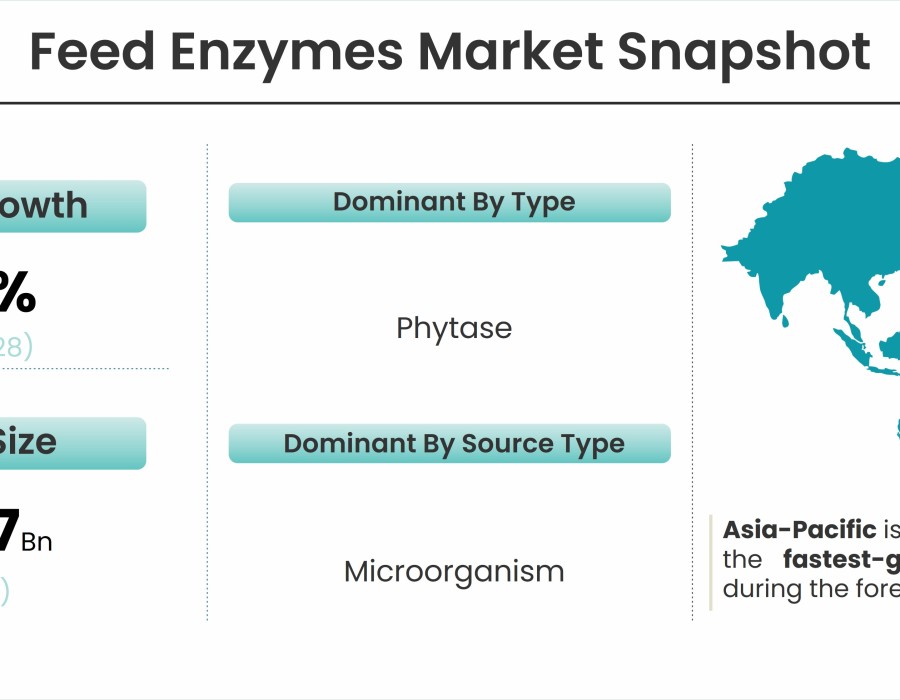In the quest for optimal animal health and performance, the role of nutrition cannot be overstated. Providing animals with a balanced and easily digestible diet is fundamental to their well-being and productivity. This is where feed enzymes come into play. These biological catalysts have revolutionized livestock nutrition, offering a powerful tool to enhance animal health and performance. In this article, we will delve into the world of feed enzymes, exploring their benefits and the profound impact they have on the agricultural industry.
According to Stratview Research, The Global Feed Enzymes Market is expected to grow from USD 1.56 billion in 2022 to USD 2.47 billion by 2028 at a healthy CAGR of 7.95% during the forecast period of 2023-2028.
Feed enzymes are gaining significant traction as they help to reduce feed costs, increase the nutritional value of feed ingredients, and improve the environment, all while maintaining or improving animal performance.
Feed enzymes are of different types such as phytase, protease, carbohydrase, and others. Phytase is the most preferred type as considered by animal feed manufacturers and livestock producers to be used as an enzyme.
To learn more about the report, click here:
https://www.stratviewresearch.com/996/feed-enzymes-market.html
Understanding Feed Enzymes
What are Feed Enzymes?
Feed enzymes are specialized proteins that accelerate chemical reactions within the digestive system of animals. They target specific components of feed, such as carbohydrates, proteins, and lipids, breaking them down into simpler forms that are more easily absorbed by the animal's body. Essentially, feed enzymes act as digestive aids, ensuring that animals can extract the maximum nutritional value from their diet.
How do Feed Enzymes Work?
Enzymes function as biological catalysts, meaning they speed up chemical reactions without being consumed in the process. In the context of animal nutrition, feed enzymes target specific types of nutrients. For example, amylases focus on carbohydrates, breaking down starches into glucose units. Proteases target proteins, cleaving them into smaller peptides and amino acids for absorption. Lipases work on fats, breaking them down into fatty acids and glycerol.
The Benefits of Feed Enzymes
Enhanced Digestibility: One of the primary benefits of feed enzymes is their ability to improve the digestibility of feed ingredients. By breaking down complex nutrients into simpler forms, enzymes reduce the burden on the animal's digestive system. This leads to a more efficient utilization of nutrients and a reduction in digestive disorders.
Improved Nutrient Utilization: Feed enzymes unlock the nutritional potential of feed ingredients. This means that animals can extract a higher percentage of essential nutrients, such as amino acids, vitamins, and minerals, from their diet. As a result, they experience improved growth rates, better feed conversion ratios, and overall enhanced performance.
Reduction of Environmental Impact: Optimizing feed efficiency through enzyme supplementation has significant environmental implications. It leads to a reduction in the amount of feed required to achieve desired production goals. This, in turn, results in decreased resource consumption, lower greenhouse gas emissions, and reduced waste output. Feed enzymes align with the goals of sustainable and responsible agriculture.
Better Gut Health: Feed enzymes play a crucial role in maintaining a healthy digestive tract. By facilitating the breakdown of feed components, they help prevent the accumulation of undigested materials that can lead to digestive disorders. This promotes a balanced gut microbiome and supports overall gut health.
Applications Across Livestock Sectors
Poultry: In the poultry industry, feed enzymes are a cornerstone of nutrition programs. They enhance the digestibility of plant-based ingredients like grains and soybean meal, leading to improved growth rates, higher egg production, and more efficient feed utilization.
Swine: Swine diets often include fibrous materials that are less digestible. Enzyme supplementation helps break down these components, resulting in improved weight gain, feed efficiency, and overall health in pigs.
Ruminants: Feed enzymes are especially valuable in ruminant nutrition. They target the digestion of fiber, ensuring that animals can efficiently extract energy from their roughage-based diets. This leads to improved milk production in dairy cattle and enhanced weight gain in beef cattle.
Aquaculture: The aquaculture industry has also recognized the benefits of feed enzymes. They are used to improve the digestibility of fish and shrimp feeds, leading to faster growth rates, reduced feed costs, and more sustainable aquaculture practices.
Conclusion
Feed enzymes have emerged as a transformative technology in animal nutrition, offering a myriad of benefits for both livestock and the environment. By enhancing digestibility, improving nutrient utilization, and promoting overall gut health, enzymes contribute to better animal performance and well-being. As the agricultural industry continues to evolve, feed enzymes will undoubtedly play a pivotal role in shaping the future of sustainable and efficient livestock production. Their impact is not only felt in the barns and pastures, but also in the broader context of global food security and environmental stewardship.
About Us
Stratview Research is a global market research firm, offering syndicated and custom research reports along with growth consulting services. Our business intelligence and industry research reports offer clients insightful market data to aid strategic decision-making. These exclusive reports are the result of exclusive research methodology and are available for key industries such as chemicals, composites, advanced materials, technology, renewable energy, and more.
Stratview Research delivers custom research services across sectors. In case of any custom research requirements, please send your inquiry to [email protected] or connect with our experts at +1-313-307-4176.





Comments